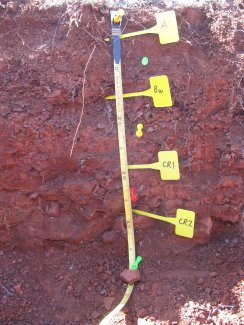Marvin Klemme Range Research Station NEON (OAES) Soil Descriptions
Distributed Soils Reports
Pedon Descriptions
Pit‐level observations and field measurements reported using the standard NRCS format. They contain volume estimates for coarse fragments > 20 mm where applicable.
Site Level Plot Summary
A narrative summary that places the sampled soil pedons in the broader context of soils and geomorphology for the entire NEON site.
Megapit Image

D11 OAES megapit soil profile 0-46 cm
| Print Date | Jul 22 2015 |
|---|---|
| Description Date | Feb 19 2013 |
| Describer | Tyson G. Morley |
| Site ID | S2013OK149001 |
| Pedon ID | S2013OK149001 |
| Lab Source ID | SSL |
| Lab Pedon # | 13N2558 |
| Pedon Purpose | research site |
| Taxon Kind | series |
| Geomorphic Setting | on backslope of None Assigned |
| Upslope Shape | convex |
| Cross Slope Shape | convex |
| Particle Size Control Section | 0 to 20 cm. |
| Country | United States |
| State | Oklahoma |
| County | Washita |
| MLRA | 78C -- Central Rolling Red Plains, Eastern Part |
| Soil Survey Area | OK149 -- Washita County, Oklahoma |
| Std Latitude | 35.4105883 |
| Std Longitude | -99.0604367 |
| Latitude | 35 degrees 24 minutes 38.12 seconds north |
| Longitude | 99 degrees 3 minutes 37.57 seconds west |
| Datum | WGS84 |
| UTM Zone | 14 |
| UTM Easting | 494513 meters |
| UTM Northing | 3918579 meters |
| Primary Earth Cover | Grass/herbaceous cover |
| Secondary Earth Cover | Savanna rangeland |
| Existing Vegetation | broom snakeweed, curlycup gumweed, plantain, prairie threeawn, pricklypear |
| Bedrock Kind | siltstone |
| Bedrock Hardness | very strongly cemented |
| Description database | KSSL |
| Diagnostic Features | ochric epipedon 0 to 8 cm. paralithic contact 20 to 46 cm. lithic contact 46 to cm. |
| Top Depth (cm) | 20 |
| Bottom Depth (cm) | 46 |
| Restriction Kind | bedrock, paralithic |
| Restriction Hardness | moderately cemented |
| Top Depth (cm) | 46 |
| Bottom Depth (cm) | |
| Restriction Kind | bedrock, lithic |
| Restriction Hardness | very strongly cemented |
| Slope (%) | 4.5 |
| Elevation (meters) | 515.0 |
| Aspect (deg) | 320 |
| MAAT (C) | 15.0 |
| Frost-Free Days | 211 |
| Horizon Details |
A--0 to 8 centimeters (0.0 to 3.1 inches); dark reddish brown (2.5YR 3/4) silt loam, reddish brown (2.5YR 4/4), dry; 14 percent sand; 58 percent silt; 18 percent clay; strong fine granular structure; loose, loose, slightly sticky, slightly plastic; many very fine roots throughout and common fine roots throughout; 2 percent nonflat angular weakly cemented 2 to 25-millimeter siltstone fragments; very slight effervescence, by HCl, 1 normal; clear smooth boundary. Lab sample # 13N03208 Bw--8 to 20 centimeters (3.1 to 7.9 inches); reddish brown (2.5YR 4/4) extremely gravelly silt loam, reddish brown (2.5YR 4/4), dry; 14 percent sand; 58 percent silt; 18 percent clay; weak fine granular structure; loose, loose, slightly sticky, slightly plastic; many very fine roots throughout and common fine roots throughout; 90 percent nonflat angular weakly cemented 2 to 20-millimeter siltstone fragments; slight effervescence, by HCl, 1 normal; abrupt smooth boundary. Lab sample # 13N03209 Cr1--20 to 31 centimeters (7.9 to 12.2 inches); red (2.5YR 4/6), red (2.5YR 4/6), dry; many very fine roots in cracks; strong effervescence, by HCl, 1 normal; clear smooth boundary. Lab sample # 13N03210 Cr2--31 to 46 centimeters (12.2 to 18.1 inches); red (2.5YR 4/6), red (2.5YR 4/6), dry; many very fine roots in cracks; strong effervescence, by HCl, 1 normal; abrupt smooth boundary. Lab sample # 13N03211 R--46 centimeters (18.1 inches); strong effervescence, by HCl, 1 normal. |
Credits: This megapit soil pedon description was generously created by USDA Natural Resource Conservation Service staff, with particular thanks to Larry West, Jon Hempel, and numerous field staff.